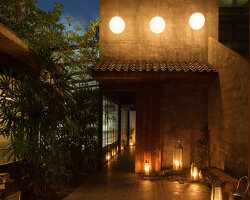
Japan’s 2025 World Expo Pavilion Highlights the Theme of Life Cycles

### Japan’s Pavilion for Expo 2025: A Tribute to the Endless Flow of Life
On **April 13, 2025**, the **World Expo** will kick off in **Osaka, Japan**, heralding a six-month-long global showcase aimed at transforming our perspectives on the future. Bearing the theme **”Designing Future Society for Our Lives,”** the expo is projected to attract over 28 million attendees and will showcase exhibitions and pavilions from **more than 160 participant nations**. Among the remarkable projects capturing attention is the **Japan Pavilion**, a carefully crafted endeavor by the esteemed architectural firm **Nikken Sekkei**.
### The Idea Behind the Japan Pavilion: “Between Lives”
The **Japan Pavilion** revolves around the concept of **“Between Lives,”** encapsulating the cyclical essence of life and interconnectedness—an essential aspect of Japanese philosophy and design. At its core is a **circular structure made from wooden planks** derived from **Japanese cedar**, selected for its visual beauty and dedication to environmental sustainability. These planks will be **reused** in various construction endeavors across Japan once the expo concludes, symbolizing a life cycle and regeneration.
The pavilion’s circular design showcases the **eternal connections among different life phases**. Visitors can gaze through the openings in the architectural slats, allowing for dual views of both the interior and exterior of the structure, as if crossing boundaries between personal and collective experiences. This design prompts us to reflect on the rhythms of life in a more interconnected and holistic way.
### Sustainability at the Heart: A Growing and Regenerating Pavilion
In a remarkable display of architectural creativity, the Japan Pavilion will also operate as a **“living” structure**. The facility includes a **biogas system** that will transform waste generated during the Expo into usable energy. This closed-loop system illustrates circularity not only through its design and building methods but also through **sustainable energy practices**. Additionally, visitors will have the opportunity to **observe the biogas process** in action at the pavilion, showcasing the typically concealed life cycle of decay, regeneration, and renewal.
This sustainable structure features **three distinct thematic areas**, each centered around the Japanese aesthetic principle of **“junkan,”** which means “circulation” or “cyclic continuity.” Junkan highlights the understanding of life as not just individual instances but as part of an endless continuum where all entities, living and inanimate, share an ongoing connection.
### A Living Tribute to Japanese Beliefs
The central theme of **“continuity”** that characterizes the Japan Pavilion transcends mere architectural elegance. It embodies a wider **cultural and ecological viewpoint** intrinsic to Japanese society. As articulated by the pavilion’s creators, **“It’s not only about us. When an animal or plant, an object, or even an entire community approaches the conclusion of its part, some aspect of it persists, evolving and assuming a new role. We all exist through these connections.”** Put differently, nothing truly concludes; every element transitions, adopting new significance and life while remaining linked to a larger whole.
Through this perspective, the **Japan Pavilion** transforms into much more than just a temporary installation created for an international gathering. It emerges as a **representation of global human interconnectedness** and a profound reflection on how we might craft the future by honoring the continuity of all existence—humans, animals, plants, ecosystems, and even inanimate entities.
### Engaging with the Japan Pavilion’s Concepts Through Digital Media
For those interested in exploring the themes that inspired this innovative pavilion, the Japan Pavilion provides a **monthly online magazine**. This publication delves into the ideas central to the pavilion’s architecture and Japanese heritage. The inaugural issue examines the philosophical and environmental notion of **junkan**, while later editions explore subjects like **microorganisms** and **human relations with nature**. For attendees unable to visit the Expo in person, the digital platform ensures that these intriguing discussions are available worldwide.
### Anticipating Expo 2025 and Beyond
Expo 2025 in Osaka is set to be a groundbreaking event featuring **state-of-the-art innovations** in technology, architecture, and sustainability at every level. Beyond its international significance, the **Japan Pavilion** stands out for its profound ties to **Japanese culture and belief systems**. It offers a singular chance for guests to connect with the idea that the **future world**—the one we aspire to design and inhabit—should be anchored in a reverence for the cyclical nature of life.
With contributions from other innovative architects such as **Kengo Kuma** (responsible for the **Qatar Pavilion**) and insights into **futuristic concepts** from nations like **Kuwait** and